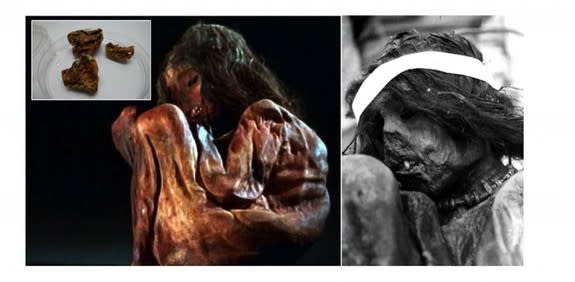Incan Child Sacrified to the Gods Reveals History of American Expansion

The mummy of an Incan child who was sacrificed to the gods more than 500 years ago belonged to a previously unknown offshoot of an ancient Native American lineage, new research finds.
The child, a 7-year-old who was found frozen in the highest reaches of the Andes in Argentina, was part of a genetic lineage that arose when humans were beginning to cross the Bering Strait or first migrating into the Americas, the researchers found. [See Photos of Incan Child Mummies]
Ancient child sacrifice
The Incan child mummy was first unearthed in 1985, when mountaineers hiking near Cerro Aconcagua (the highest mountain outside Asia) discovered a partially unearthed frozen mummy at an altitude of about 17,400 feet (5,300 meters). The group went back and alerted archaeologists, who conducted an official excavation.
It turned out that the mummy was the remains of a little boy, about 6 or 7 years old, who was wrapped in textiles and buried with six or seven little statues. Based on the finds, the archaeologists concluded that the boy was a victim of "capacocha," a ritual sacrifice practiced by the Incas about 500 years ago.
"The sacrificial rites involved children of great physical beauty and health in honor of the gods; the rituals were performed during or after important events (death of an emperor, the birth of a royal son, a victory in battle or an annual or biennial event in the Inca calendar), or in response to catastrophes (earthquakes, volcanic eruptions and epidemics)," the researchers wrote in the paper, which was published today (Nov. 12) in the journal Scientific Reports.
Victims were gathered from anywhere in the far-flung Incan territory, which at its height stretched along the coastline from Ecuador to south-central Chile. The chosen children were then drugged and sent off to freeze to death in the mountains.
Recreating population history
The researchers managed to extract mitochondrial DNA, which can trace the maternal lineage, from a small portion of the boy's lung.
The team found that the boy belonged to a genetic lineage known as C1b, which was one of the founding lineages of people who first colonized the Americas.
But the boy was part of a genetic offshoot, called C1bi, that had never been found previously in modern-day South Americans. However, by poring over huge databases of genetic information, they found a few people living today among the Aymara people in Peru and Bolivia who had the same lineage.
The team was also able to reconstruct a broad picture of how the population changed over millennia, by comparing the genetics of the Incan child mummy with other known C1b genomes. Based on that data, the team confirmed that the ancient C1b lineage first arose about 18,000 years ago, when the ancestors of modern-day Native Americans were still trapped in the Bering Strait region or perhaps had just emerged into North America, the researchers wrote in the paper. (Scientists aren't sure whether the ancestors of Native Americans remained in the Bering Strait area for about 10,000 years before entering the Americas or if they crossed the strait and quickly colonized the Americas.)
The C1bi offshoot emerged later, about 14,300 years ago.
"In agreement with previous findings, the fact that C1b is only slightly older in Mesoamerica than in South America confirms that the southward expansion of this clade was very rapid," the researchers wrote.
Expansion and collapse
After the rapid expansion into the Americas, the population grew until about 9,000 years ago. Then, the population shrank for 4,000 years. The population then rose steadily until it collapsed with European colonization, about 500 years ago, genetic data revealed. (This last expansion coincided with the abandonment of hunting and gathering and the more intensive use of agricultural practices, the researchers wrote in the paper.)
In addition, they found that the boy shared a genetic lineage with an ancient inhabitant of the Wari Empire, which dominated the Peruvian highlands from A.D. 500 to A.D. 1100. That suggests the boy's lineage, which is rare today, may have once been much more common, the researchers wrote in the paper.
Follow Tia Ghose on Twitterand Google+. Follow Live Science @livescience, Facebook & Google+. Original article on Live Science.
Copyright 2015 LiveScience, a Purch company. All rights reserved. This material may not be published, broadcast, rewritten or redistributed.

 Yahoo News
Yahoo News 
